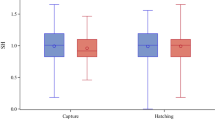Abstract
Populations of the vernal cladoceranDaphniopsis ephemeralis are found in woodland ponds throughout southern Ontario. The species reproduces by cyclic parthenogenesis, and genotype frequencies at allozyme loci are ordinarily in good agreement with Hardy-Weinberg expectations. Occasional heterozygote deficiencies are apparently the consequence of admixture of ephippial hatchlings produced in temporally separated bouts of sexual reproduction. Considerable heterogeneity in genotypic frequencies exists among local populations in southwestern Ontario, indicating that gene flow among populations is restricted. Inbreeding coefficients suggest that populations receive an average of 0.3 migrants per generation. The completion of a sexual life cycle is made possible despite the brief persistence of populations by the emergence of males from ephippial eggs and by the production of equal numbers of male and female progeny in the first parthenogenetic brood.
Similar content being viewed by others
References
Banta, A. M. & L. A. Brown, 1929. Control of sex in Cladocera. III. Localization of the critical period for the control of sex. Proc. Natn. Acad. Sci. U.S.A. 15: 71–81.
Ferrari, D. C. & P. D. N. Hebert, 1982. The induction of sexual reproduction inDaphnia magna: genetic differences between arctic and temperate populations. Can. J. Zool. 60: 2143–2148.
Frey, D. G., 1982. Contrasting strategies of gamogenesis in northern and southern populations of Cladocera. Ecology 63: 223–241.
D'Abramo, L. R., 1980. Ingestion rate decrease as a stimulus for sexuality in populations ofMoina macrocopa. Limnol. Oceanogr. 25: 422–429.
Hebert, P. D. N., 1974. Enzyme variability in natural populations ofDaphnia magna. I. Population structure in East Anglia. Evolution 28: 546–556.
Hebert, P. D. N. & T. Crease, 1980. Clonal coexistence inDaphnia pulex (Leydig): another planktonic paradox. Science 207: 1363–1365.
Hebert, P. D. N. & C. Moran, 1980. Enzyme variability in natural populations ofDaphnia carinata. Heredity 45: 313–321.
Hebert, P. D. N. & W. J. Payne, 1985. Genetic variation in populations of the hermaphroditic flatwormMesostoma lingua (Turbellaria, Rhabdocoela). Biol. Bull. 169: 143–151.
Leary, D., 1967. Induction of males and ephippial eggs inDaphnia pulex. M.S. Thesis, University of Maryland.
Mellors, W. K., 1975. Selective predation of ephippialDaphnia and the resistance of ephippial eggs to digestion. Ecology 56: 974–980.
Nei, M., 1975. Molecular population genetics and evolution. North Holland, New York, 288 pp.
Schwartz, S. S. & P. D. N. Hebert, 1985.Daphniopsis ephemeralis sp.n. (Cladocera: Daphniidae): a new genus for North America. Can. J. Zool. 63: 2689–2693.
Stross, R. G. & J. C. Hill, 1965. Diapause induction inDaphnia requires two stimuli. Science 150: 1462–1464.
Stross, R. G. & J. C. Hill, 1968. Photoperiod control of winter diapause in the fresh water crustaceanDaphnia. Biol. Bull. 134: 176–198.
Wright, S., 1978. Evolution and the genetics of populations, Vol. 4. Variability within and among natural populations. University of Chicago Press, Chicago, 580 pp.
Author information
Authors and Affiliations
Rights and permissions
About this article
Cite this article
Schwartz, S.S., Hebert, P.D.N. Breeding system ofDaphniopsis ephemeralis: adaptations to a transient environment. Hydrobiologia 145, 195–200 (1987). https://doi.org/10.1007/BF02530280
Issue Date:
DOI: https://doi.org/10.1007/BF02530280




